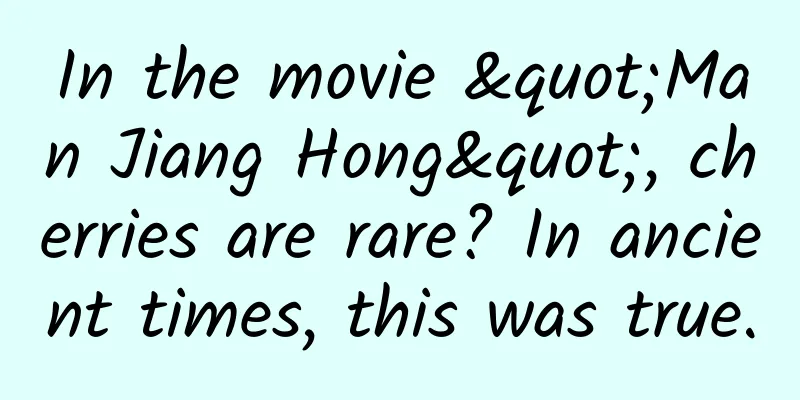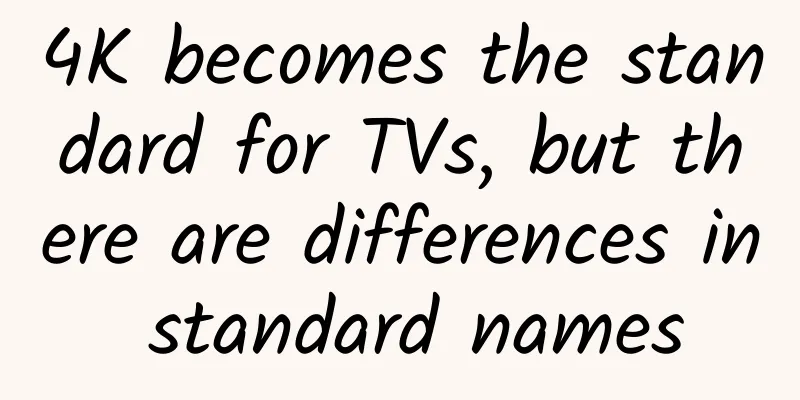In the movie "Man Jiang Hong", cherries are rare? In ancient times, this was true.

|
In the movie "Man Jiang Hong" which was released during the Chinese New Year of the Rabbit, the screenwriter and director repeatedly used a joke, which was the edible fruit cherry and the image of cherry in poetry. In the movie, when Tao Yatou appeared, she treated the cherries given by her mother as treasures, and the coachman (actually her biological father) who treated her well was reluctant to give her even one. Tao Yatou in "Man Jiang Hong" Cherries, which are now very common in fruit stores, were known as the "first fruit of early spring" in ancient times. They were a luxury or royal tribute that ordinary people could not even see, let alone eat. It was natural for Tao Yatou to treat cherries as treasures. The first spring fruit high-end tribute Cherry has a history of thousands of years of cultivation and medicinal use in my country, and the origin of its name is the best proof. According to the Three Kingdoms pharmacopoeia "Wu Pu's Materia Medica", because it looks like a young peach and more like a red pearl (referring to jade beads used as ornaments), it is called "cherry" based on homophony. "Its buds are like pearls, so it is called cherry," the Ming Dynasty pharmacopoeia "Compendium of Materia Medica" records. In addition, because it is deeply fed by the yellow oriole and "is ashamed to hold the peach in its mouth and offer it to the emperor's temple first" (The Book of Rites, Monthly Ordinances, Eastern Han Dynasty), cherries are also called oriole peaches, holding peaches, etc. Cherry is also a precious medicinal material in the eyes of the ancients. Chinese medicine believes that it can regulate the middle and replenish qi (regulate blockage, replenish qi deficiency), treat physical weakness, and moisturize the skin. Pharmacopoeias such as "Prescriptions for Emergencies", "Southern Yunnan Materia Medica", and "Compendium of Materia Medica" all have records of it. Cherries can also be used as medicinal materials (Source: Baiguo.com) Due to the underdeveloped cultivation and storage technology and backward logistics, cherries were mainly used for high-level sacrifices or royal tribute. According to research, in the Western Zhou Dynasty, Chinese working people began to grow cherries for the royal family to worship the ancestral temple, which was a high-level offering; in the Han Dynasty, cherries were regarded as royal tributes, and the first person to enjoy them was the emperor; in the Southern and Northern Dynasties, the cultivation technology was improved, and cherries changed from offerings to tributes, entering the court officials or officials’ homes; in the Tang Dynasty, the royal family headed by the emperor liked cherries very much, and the first batch of cherries harvested in late spring every year was first sent to the emperor’s ancestral temple, and then they were rewarded to princes or important officials with gold plates, gold chopsticks, and silver spoons. As cherries were too precious, ordinary people were reluctant to eat them and only picked them and sold them to the rich and powerful to make a living. In the famous novel "Water Margin", there is a plot in which Qiao Ge from Yuncheng offered cherries to Ximen Qing and was rewarded. Cherries painted by famous artists (Source: Chinese Painting Network) As one of the first fruits to ripen in late spring and early summer, cherry was called "the first fruit of early spring" and "the first branch of all fruits" by the ancients. There are many poems praising cherries, using them as a substitute for objects or expressing beautiful emotions, especially in the Tang and Song dynasties. "Cut the rare and precious, ashamed to share the glory with others", the poem of Tang Xiang Sun Ti shows the high value of cherries; "The flowers bloom early in the spring, and the snow and clouds decorate the petals lightly", the famous line of Tang Dynasty poet Li Shen praised the beauty of cherry blossoms early; "A tree of peaches is full of fire, and now it is dedicated to the isolation palace in spring, only the tears of the warriors are worried about the time, and the branches are sprinkled with red dots", the Neo-Confucianist Liu Zihui of the Song Dynasty used cherries to describe the sad tears shed for the country; "Time flies away easily, cherries turn red, bananas turn green", the poet Jiang Jie in the late Song Dynasty used "cherries turn red" to describe the fleeting spring melancholy... Fruit of Life, loved by citizens Cherry has the word "peach" in its name, but it is not a peach, but a kind of plum. From the perspective of plant taxonomy, it belongs to the genus Prunus under the Rosaceae family. There are currently four types of cherries discovered, namely, Prunus cerasus (also known as Chinese cherry), Prunus pubescens, European sour cherry and European sweet cherry. Cherry is recognized worldwide as the "king of natural vitamins" and the "fruit of life", and is extremely nutritious. Chinese cherries (Source: Baiguo.com) Due to low yields and backward cultivation techniques, there are few cherries planted in China, and promotion is not strong. This situation changed after the introduction of European sweet cherries in the late Qing Dynasty. European sweet cherries are generally referred to as sweet cherries, and are also called big cherries because of their large size. Varieties include Naweng, Da Zi, Wan Huang, etc. Around 1885 AD, Wang Ziyu, a villager in Yantai, Shandong, introduced "Naweng" sweet cherries from Korea; in 1890 AD, Zhu Deyue, a villager in Zhifu District, Shandong, introduced "Da Zi" sweet cherries. These two events marked that Western cherries officially took root in China. However, the original sweet cherries were mainly planted in courtyards or temples in the north, and the production areas were limited to Yantai, Shandong, Dalian and other places. In the 1980s and 1990s, because Chinese cherries and hairy cherries were difficult to grow in southern my country, and in order to increase the planting and promotion of cherries, my country began to introduce and test sweet cherries in Shanghai, Nanjing, Anhui, etc. Since then, with the advancement of planting technology, various types of cherries have been produced and promoted all over my country. Sweet cherries have another well-known name, which is cherries, which is taken from the transliteration of the English word cherry. Cherries and the cherries we usually buy (i.e. Chinese cherries) are two different varieties of the same genus. Cherries and Chinese cherries have certain differences in color, size, taste, etc. Cherries are smaller, have less flesh, and taste sour and sweet; cherries are larger, have more flesh, and taste sweeter (basically no sourness). In terms of nutritional value, there is not much difference between cherries and cherries. Cherries have a higher iron content, so those who want to prevent iron deficiency anemia can give priority to cherries. Because cherries are firm and durable in storage, and can be kept fresh for more than a month if properly preserved, fruit vendors call cherries "off-season cherries." For various reasons, cherries are more than twice as expensive as cherries on the market. Cherries and cherries (see watermark for image source) Finally, the line “The cherries are red, the banana leaves are green” sung by Shen Teng in “Man Jiang Hong” comes from “Yi Jian Mei·Boat Passing Wujiang” by Jiang Jie, a “Cherry Jinshi” from Yixing, Jiangsu. Jiang Jie passed the Jinshi exam in 1274, two years before the fall of the Southern Song Dynasty. The movie “Man Jiang Hong” tells the story of the early Southern Song Dynasty, four years after Yue Fei’s death (1146 AD). According to this calculation, when the story in the movie took place, the lines “The cherries are red, the banana leaves are green” had not yet been born. Despite this, cherries were still a rare commodity at the time, and it did not affect people’s love for them. "The cherries are red, the bananas are green" (see watermark for image source) References: 1. Paper "Cultivation and Management of Big Cherry", Zhang Hua, "Technical and Scientific Papers" 2018 2. On Cherry in Chinese Classical Poetry, by Qian Yingying, Selected Chinese Papers (2017) 3. Classics such as "Compendium of Materia Medica", "Book of Rites", "Prescriptions for Emergency", "Water Margin" and so on END Author: Wei Deyong, member of Shenzhen Writers Association, Guangdong Editor: Guru |
>>: If you have these 5 daily necessities at home, it is recommended to throw them away immediately
Recommend
Five major trends in intelligent connected cars: cars will become computers on wheels
Technology is reshaping the future of the global ...
Four reasons you don't need to replace your smartphone every year
Smartphones have made significant progress in the...
Is the "magic medicine" for hepatitis A really what was exchanged for the color TV ticket in "Fanhua"?
This is the 4875th article of Da Yi Xiao Hu There...
Audi: In 2023, Audi delivered a total of more than 729,000 vehicles in the Chinese market, a year-on-year increase of 13.5%
According to recent news, according to the sales ...
B2B website SEO case analysis, SEO inquiry volume data analysis!
When a company does online network promotion, whe...
The download cost is 5.6 cents? This is how you should use Tencent’s 10 billion social advertising traffic!
Some time ago, Tencent announced that it would in...
Medical beauty industry promotion case analysis
1. Project Background In the age of appearance, a...
High-traffic and high-concurrency solution course
: : : : : : : : : : : : : : : : : : : : : : : : : ...
The effects of Guangdiantong and WeChat Moments are not good? Key points for account operation!
There are countless channels for information flow...
What is happiness? This question has been answered by many people. In fact, Aristotle has already given the answer
© The Collector Leviathan Press: Whenever we talk...
Qoros Model Young SUV debuts at Guangzhou Auto Show: its last act before being abandoned by Chery?
At the 2017 Guangzhou Auto Show, Chery officially...
In addition to asking about the weather and setting alarms, do you know how to use these Siri skills?
Hey Siri, what can you do for me? Although for so...
How does a P2P platform choose high-quality channels?
As we all know, the cost of acquiring P2P custome...
Special collection of 5G smart campus solution providers!
In the 5G era, 5G application scenarios are gradu...
Check out the 8 major monetization methods on Zhihu!
Has your Zhihu been monetized? The operation of a...









